Okay, guess I’m getting my annual irrational urge to play a 40K game out of the way early this year.
Battlesector is a turn-based strategy game that reminds me an awful lot of Chaos Gate. By that I don’t mean they’re the same in terms of content, although they do have quite a lot in common (fielding small Space Marine armies versus much larger enemy forces, linear single-player campaign, ability to field vehicles), but rather in terms of general game feel. Chaos Gate was an incredibly shonky game in terms of art and UI and general player experience, but which nonetheless had a decent design core to it that sustained the game into the later stages while it weathered an exponentially increasing number of bugs. Battlesector has fewer bugs, but the art and UI are definitely prime contenders for the 2022 Shonkiness Awards; balancing that out is a surprisingly thoughtful take on the combat mechanics that’s reasonably interesting to engage with and which is only ultimately undone by some baffling decisions around the balancing of the campaign missions.
Battlesector pits the Space Marines of the Blood Angels against the invading Tyranid hordes of Hive Fleet Kraken. Unusually, though, these aren’t the same Space Marines who spent large portions of their time in Dawn of War screaming “PURGE THE XENOS!” at the top of their lungs; Battlesector is only the second 40K game I’ve played that takes into account the fact that Games Workshop actually moved the timeline forwards by a millennia or two a few years ago. While progressing the story and the setting like this was sorely overdue, it was a mere side effect of the real reason they did it: so that they could release an entirely new line of Space Marine miniatures (thanks to somebody finding the Emperor’s Space Marine Cookbook) and rake in even more cash from 40K’s poster boys. Battlesector therefore stars the Primaris Space Marines, whose main distinguishing features compared to classic flavour Marines are that they are bigger1, have even more overdesigned armour, and slightly-renamed, more conveniently-trademarkable versions of the standard 40K weapons and squad compositions. So instead of tactical squads armed with bolters, the Primaris get Intercessors with bolt rifles; instead of devastator squads with heavy weapons, they get Hellblasters with plasma incinerators; and instead of assault squads with jump packs, bolt pistols and chainswords they get Inceptors dual-wielding assault bolters.
Now, aside from serving as ample confirmation of how creatively bankrupt Games Workshop are, I find the choice to put the Primaris front and centre interesting because the reason you make a 40K game is to hook in people like me who grew up with the 40K setting and who wouldn’t otherwise give your game a second glance if it didn’t have Space Marines and Terminators in it. But that’s precisely what Battlesector doesn’t have; the Primaris aren’t familiar things for anyone who hasn’t been following the setting closely for the last three or four years because they don’t have any presence outside of the miniatures. I feel this is why Battlesector doesn’t get as far on that 40K license as it really should, despite throwing in a few sops to the old guard like Dreadnoughts, Predators and classic Assault Marines (although I think the last are just there to highlight how rubbish they are in comparison to the Primaris equivalent and to encourage you to upgrade your army as soon as possible). I also have a bee in my bonnet about the modern Tyranids, who have had all of the colour and character leeched out of them, and because Battlesector is set on one of the irradiated desert moons of the Blood Angels homeworld it makes the same mistake just about every other 40K game has: having really bland terrain and scenery. No matter how much tedious prose its motley cast of Astartes spout in the mission briefings (the phrase “weave and weft” comes up more than once) Battlesector is just not a good adaptation of the 40K universe — or at least not a fun one.
But enough about my issues with the modern 40K setting; what does Battlesector look like when you peel back that superficial skin and get into the guts of the mechanics? The single-player campaign is nothing fancy, a linear sequence of twenty missions in between which you upgrade your army via a selection of skill trees and customise your force composition. Mission maps are square grid-based rather than hex-based, and the basic mechanics themselves can be described as Panzer General-tier, or wargame-lite:
- Each unit has separate pools of 4+ movement points and usually just one action point, although your character units get two. Action points are used to either attack or activate a special ability, and they can be used at any point in a unit’s turn, allowing them to pop out of cover, fire their weapons, and then scuttle back in again.
- Units are composed of multiple models, and when an attack is made each model will fire the number of shots that model’s weapon allows — a unit of five Hellblasters with heavy plasma incinerators get just one shot per model, so five shots, while the dual-wielding Inceptors may only have three models in their unit but each one can rattle off 24 shots with their assault bolters, making 72 shots in total.
- While that might sound like a lot, each individual shot has a chance of missing. Shot accuracy is affected by the weapon’s optimal range, with dramatic accuracy falloff if you’re trying to fire inside or outside of that range, and any cover or blocking units that might be in the way, which the game treats more or less as the same thing. You can fire through your own units to hit a target on the other side and there won’t be any friendly fire, but you will incur a substantial penalty to accuracy.
- If a shot hits, there’s then the question of how much damage it does. This is calculated by comparing the attacking weapon’s Armour-Piercing rating against the target’s Armour rating. Weapons with a lower Armour-Piercing rating will do less damage, and if it’s too low the shot will do no damage whatsoever.
- And if a shot does damage, it might end up killing a model in the target unit. Each model in a unit has its own individual HP bar; once this is reduced to zero, it will die, reducing the number of shots it can make per attack. While a unit can keep fighting until all of its models are dead, it’s going to be much less effective if it’s suffered 80% casualties.
There’s other systems rattling around the edges of this tactical core — special abilities such as throwing frag grenades to one-shot weaker units or buffing your army’s accuracy against a high value target, and the Momentum system that grants bonus action points once a unit has racked up a sufficiently high kill count — but leveraging each of these bullet points in the right way to maximise my damage output while trying not to leave my troops exposed to counterattacks is the thing that occupied most of my thinking time in Battlesector. One surprising thing about the game is that thanks to those optimal range penalties and the weapon loadouts available to the Primaris units the Blood Angels end up being quite a short-ranged army, with the only units able to attack effectively at ranges beyond two or three tiles being the Land Speeder and the basic Intercessor tactical squads. Since you are fighting the Tyranids — who are a vast beclawed horde of alien threshing machines and the biggest, scariest close-quarters battle specialists in the setting — this results in most tactical decisions being a risk/reward judgement: is it worth sending your Inceptors leaping into optimal range for their pistol attack, but also into charge range of those two units of Hormagaunts? That big Tyrannofex will die if you can get your Sergeant to smack it with his Thunder Hammer, but you’ll have to be sure you can also clear out all of the units of supporting Genestealers before they tear him to shreds.
Deciding how and where to allocate your firepower for maximum effect, keeping the Tyranid hordes thinned out so that they can’t overwhelm you, is you the real meat of Battlesector. There’s some really good work that’s been done on unit design on the Blood Angels side, so that almost every single unit remains relevant throughout the entire length of the campaign. In the very first mission you’re handed three units of Intercessors and two units of Aggressors (short ranged tanky infantry that have cribbed a lot from Starcraft’s Firebats2), and I took the two surviving units of Intercessors and one Aggressor unit into the final campaign mission because they still had a tactical niche; the Intercessors put out reliable long range damage on unarmoured units (which is most Tyranid units) and while the Aggressors’ short-range boltstorm gauntlets really fall off in the midgame I still kept a unit around for their armour-piercing close-combat attack, which was capable of removing almost half of the health of a big tanky Tyranid. Land Speeders can both scout and snipe high value targets with their Heavy Bolters, which have reasonable armour penetration, while Dreadnoughts and Predators are somewhat interchangeable as big sacks of heavily-armoured HP that anchor your line and can lay down a fearsome hail of short-range fire. Most units have multiple weapon choices that can eventually be unlocked via the inter-mission skill tree, but I actually stuck with the default options for nearly all of them as the alternatives seemed to make them even more specialised to the point of not being useful in 90% of battlefield scenarios.
The sole exception to this were the Inceptor assault infantry, and it’s here that we start to run into some of the problems with Battlesector’s setup. Inceptors become available about six missions into the campaign; up until that point I was using bog-standard Assault Marines, who I have a real soft spot for because there’s few things more 40K than a screaming lunatic with a jetpack and a chainsaw. Assault Marines have their uses as the jump packs let them reposition quickly, but as the only real “classic” Space Marines in the Blood Angels roster I was also noticing that they were substantially weaker than the Primaris troops thanks to a lower armour stat. They also had trouble causing damage when their jump packs were on cooldown, as unless they’re jumping into combat their melee attacks get countered by any surviving units and their chainswords don’t do anywhere near enough damage to kill models before they can perform said counter. Inceptors have none of these weaknesses; they have high armour, can put out an absolutely ridiculous amount of damage with those 72-shot attacks, and they aren’t even weak to melee thanks to every unit with a pistol weapon being allowed to do a free “reaction attack” against any unit charging them from the front . The Assault Marines were rendered wholly redundant the moment I got them, which was a bit of a problem when I’d invested non-refundable skill points into upgrading them and trying to make them a bit better. It got worse once I upgraded the Inceptors with the ability to (effectively) use their jump packs every turn, and also gave them plasma pistols that let them put the hurt on even heavily-armoured targets; they ended up forming a third of my army because they’re good in pretty much every situation, which was a rare oversight for Battlesector.
There’s also a phrase in the above paragraph that points to wider problems with the campaign: “high armour”. All Primaris units, and hence the entire Blood Angels army (except Assault Marines), have high armour — much higher than the vast majority of Tyranid ranged weapons can penetrate with their measly Armour-Piercing scores. Even the Intercessors can tank four or five volleys of incoming fire before losing a model; Termagants and Gargoyles (the most common Tyranid units) can’t even hurt Aggressors and they can barely touch Inceptors. Tyranid melee attacks are a different story, but it’s extremely rare that they’ll get to use one in any significant way thanks to the existence of Overwatch; much like in XCOM, this allows you spend a unit’s action point to fire at any Tyranids who are attempting to close to melee on their turn, and then your pistol units (who you’ve put in the frontline if you have any sense) get another free reaction attack if they actually make it to melee, and there’s not really much left of any charging Tyranid unit after that. And once you get Dreadnoughts and Predators that’s about it for the Tyranids as a plausible attacking threat because there’s something in the Tyranid AI that compels them to attack your vehicles first, and they have nothing that can threaten armour in any serious way. A Broodlord managed to make it into close combat with a Predator once and knocked off half of its health, and then the return fire from the Predator’s assault cannons mulched it; until the final mission, that was as close as the Tyranids came to blowing up one of my vehicles, and in fact they only managed to kill four units total. And two of those were Assault Marines, so they don’t really count.
(The reason the “until the final mission” rider is in there is because this is how long Battlesector waited before hitting me with sufficient big Tyranid units across a wide enough front that I couldn’t kill them all before they got to melee range. They also fielded a single unit of Hive Guard with a hitherto-unseen electric cannon that unexpectedly killed a Dreadnought; I also lost two other units to the big Tyranids, but it was the final mission of the campaign so who cares.)
It’s because of this that I almost packed in Battlesector completely five missions before the end of the campaign. I’d effectively solved the game (on Normal, anyway) and going any further would simply be a matter of box ticking, which is possibly not the best use of my time when each mission in Battlesector takes an hour plus to complete. To its credit it does do more than certain other 40K adaptations I could name to try and speed up the process of taking a turn; you can give units movement orders and even attack orders simultaneously and they’ll move and attack at the same time, and Tyranid move orders will also happen simultaneously for small groups of 2-3 units instead of making you watch as the game dripfeeds them into visual range one unit at a time. There’s also a button to increase the animation speed on the Tyranid turn, although there’s no equivalent for the Blood Angels (I found the spacebar-to-fast-forward feature to be incredibly useful in XCOM). There is still a substantial amount of waiting around because there’s just so many Tyranid units and the game will even make you wait while it moves the ones outside of visual range, but the real time sink happens on the player turn because of the amount of scutwork you have to do to compensate for Battlesector’s UI.
Again, I’m trying to be reasonably measured here. UI is tricky to do for a strategy game, especially if you don’t have a huge amount of resources to throw at the problem. I want to be somewhat understanding of the fact that Battlesector surfaces only the most basic to-hit information in its primary UI, with the accuracy bonuses and penalties relegated to an interface best described as “a big list of stuff” that you can make appear by right-clicking on a unit. But it doesn’t even go for the easy wins, like colour-coding the bonuses/penalties appropriately, and while it does surface optimal range on the battlefield (although it’ll take a few missions before you understand what you’re looking at) it does absolutely nothing to help you figure out where the best place to shoot from is. The best interface I’ve seen for this so far is the one from Wasteland 3 (of all things) which let you click on a square in movement range and would then show you every single enemy which was in range of that square and their associated to-hit probability; Mechanicus had one that was similar3 which is probably where Wasteland 3 got the idea from. There’s none of that in Battlesector, though, and there were too many missions where I found myself manually counting out a five-square distance from a target unit so that I could move my Land Speeders into a good attack position for their Heavy Bolters, or counting out movement ranges so that I could shuffle units through a firing rotation without them blocking each other.
It gets even worse for cover modifiers; I have now finished the Battlesector campaign, and I’m still not quite sure how cover works. Sometimes things are in “full cover” and I can’t shoot them but I have no idea how that’s different from partial cover; it looks exactly the same as a single piece of cover to me. Bizarrely, being adjacent to a piece of cover (or taking cover behind it, in other words) appears to block your outgoing shots just as effectively as it will incoming fire, and so you have to abuse the fact that you can move out of cover, fire, and then move back into it. My suspicion is that cover is actually based on a direct line-of-sight calculation that takes into account the number of objects present that break that line, whether they’re scenery or other units; this theory is supported by the time I moved my Land Speeders to a position that looked like it had a 100% clear field of fire but which nevertheless incurred a cover penalty, and further inspection revealed the curvature of the ground meant it partially blocked the shot. I had absolutely no way of knowing this, though, because you’re stuck with the same 45 degree camera angle throughout the game with no way of zooming down to ground level to eyeball it. Again, Steel Division has an excellent LOS tool that could have been cribbed for Battlesector, but for whatever reason there’s been no time, resources or willpower to do anything more than throw together the most basic stat summary, hide it inside a right-click interface, and then call it a day.
And then there’s that art and animation, which contributes greatly to the general shonky feeling I mentioned up top. Battlesector is far from the worst-looking game I’ve ever played, and the 3D-ness of it all means it cleans up quite nicely for screenshots, but unfortunately it’s a much uglier thing to look at in motion. There’s only so many variations of “desert” and “industrial park” that I can look at before I start to get bored; the precise number is “one” and “zero” respectively. Melee attacks have no weight or heft to them whatsoever, and for the bigger Tyranid units looks more like “awkward poke” than it does “melee attack”. Tyranid ranged attacks are some of the weakest, splattiest blobs of green snot I’ve seen in a videogame, which I suppose does match their gameplay effectiveness but isn’t a particularly exciting thing to watch unfold in front of you. Waiting for the Aggressors to waddle their way from position to position is borderline comical, and the Sergeant’s run animation looks like he’s being controlled by a QWOP player. None of this is helped by the unit barks — hearing the Dreadnought’s robotic “URRGH…” every time it takes 1HP of damage makes it sound like it’s achieving climax during particularly busy Tyranid turns, while the Aggressors’ “ROGER THAT” is phrased more like an imperative than it is an acknowledgement — and the voice acting in general is all first-take quality, with the Sister of Battle voice actress in particular making a meal of a lot of her lines4 that nevertheless have ended up in the final product.
So, when you balance out the decent tactical core with the numerous aggregated shortcomings elsewhere, and adjust for the fact that it is an indie game with a limited budget despite its fancy 3D graphics, Battlesector turns out to be something quite unusual: a Warhammer 40,000 adaptation that is merely… there. Usually they provoke a quite visceral reaction in me one way or the other, but I don’t feel strongly about Battlesector at all; it has precisely none of the brutal joie de vivre that the better 40K games like Dawn of War and Mechanicus and Battlefleet Gothic possess in spades, but because it focused on the Tonka Toy Primaris marines rather than anything I’d recognise as authentically 40K this somehow didn’t matter so much. It was engaging for about two-thirds of its length so it’s immediately better than some of the utter shite that has previously graced the metaphorical pages of this blog, and you could definitely do worse if you have a tactical strategy itch that needs scratching and are willing to clamber over the UI problems to get it done. But I’m hardly about to recommend that anyone rush out and play it right now unless you really have nothing better to do.
- As this chart shows, 40K has a really weird thing going on where size is a proxy for power level. ↩
- Which is only fair seeing how much “inspiration” Starcraft took from 40K. ↩
- Except shots always hit in that game so it didn’t need to surface a to-hit percentage. ↩
- I don’t particularly blame her, it must be hard to spout all of this nonsense in the authentically cut-glass, stentorian tone required for 40K while keeping a straight face. ↩

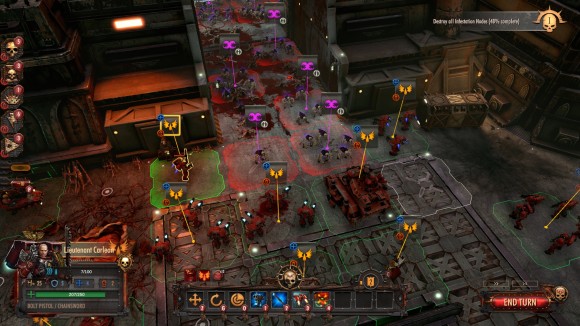
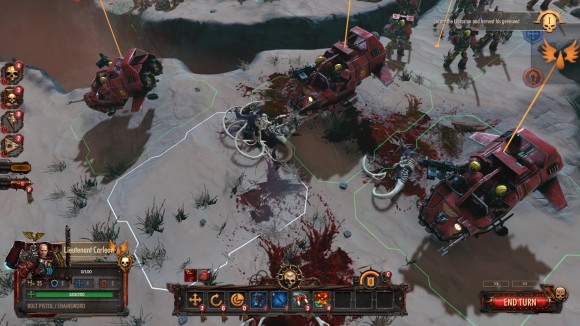
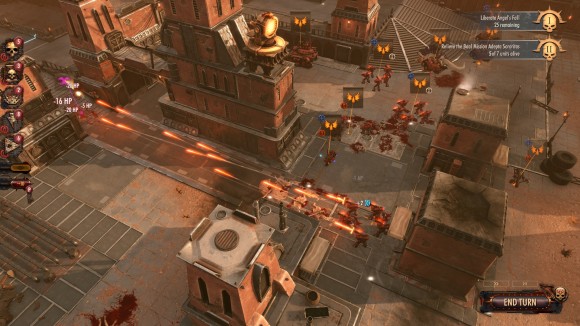
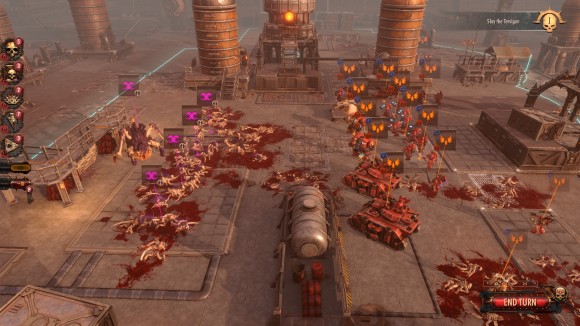
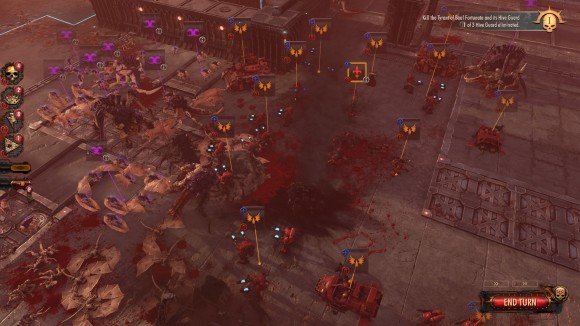
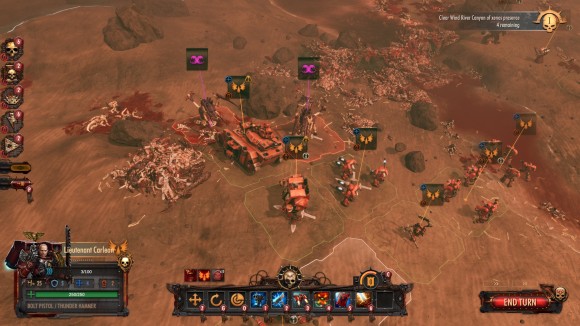
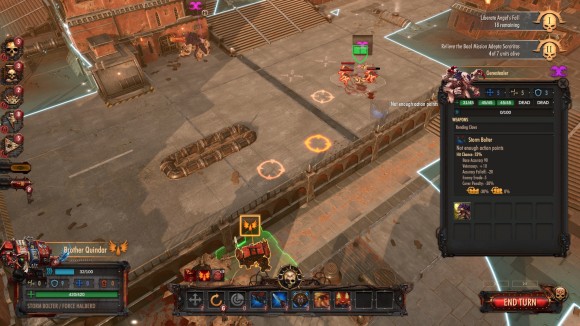
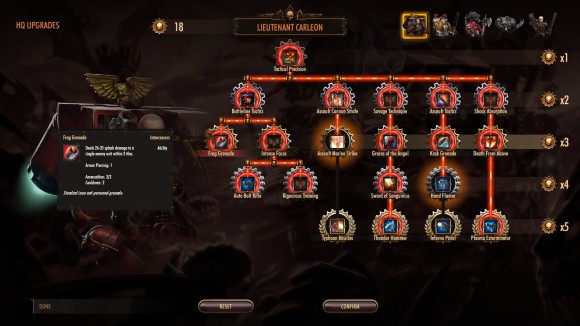
I liked it, didn’t love it. Could’be been better but definitely could’ve been worse. It’s worth a play through, especially for 40k fans.
Thanks for this write-up! It’s been on my radar and seems like it’s probably not worth looking into. Although at least it sounds like it doesn’t fall into the Battlefleet Gothic problem of having a campaign that’s a hundred hours long even though you’ll see basically everything the game has to offer mechanically in an hour or so. (This is a consistent problem with strategy games, I’ve noticed.)
for a scientific titled blog most of your comments are emotional and penitential.